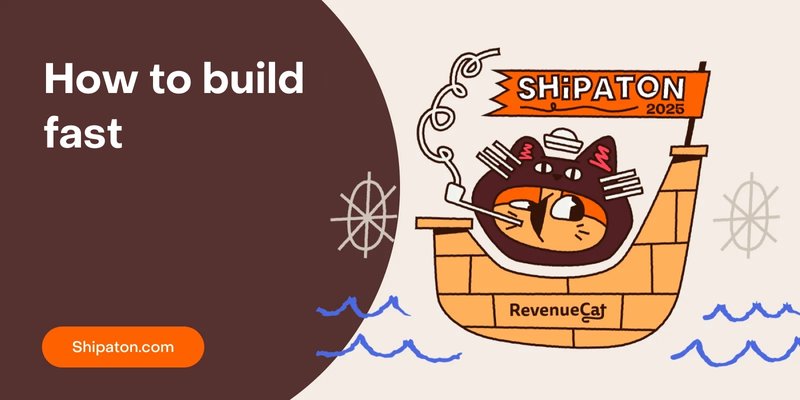Shipaton is in full swing with 49 days still on the clock. That’s plenty of time to come up with an idea, build it, ship it, and turn it into something big. This week’s guide focuses on execution: how to build efficiently, avoid wasted effort, and get your app into users’ hands as quickly as possible.
The key to managing your time is starting small but lovable. Aim for a minimum lovable product (MLP) that delivers the core experience people will enjoy right away. Then grow it based on real feedback. If you missed last week’s guide on finding your idea, narrowing your focus, and iterating with users, read that first. Once you’re clear on the “what,” this article will help you nail the “how.”
Set a timeline, and stick to it
Deadlines are what turn ideas into finished products. App development is no different. Your first goal is to build something you can put in front of potential users as quickly as possible. The longer you spend building in isolation, the greater the risk of creating something no one needs — or will pay for.
One way to keep yourself on track is with what I call the 4-8-24 approach. I first used this while working on proof-of-concepts and prototypes at a previous company. At the time we applied it instinctively, but later I shaped it into a repeatable framework I’ve used for app development, project management, and even to keep my easily distracted brain focused on a single task.
The idea is simple:
- 4 hours to build the first version.
- 8 hours to polish it enough to show real users.
- 24 hours (spread over three days) to refine, package, and release.
Each stage has a clear purpose and a strict time limit — both are essential for moving fast without losing direction.
Build in 4 hours
The first four hours are about proving to yourself that the concept works, and that it’s worth continuing. The time limit is artificial, but it’s important. At this point you don’t need to show the app to anyone, but it should instantly communicate what it does. Ideally, it even delivers the core feature in some form.
It doesn’t have to be perfect. If there’s an API you need to call, mock it for now and build the app as if the response were real. You can even use the Wizard of Oz method: a polished-looking UI with someone manually “pulling the levers” behind the scenes to make things work.
The goal here is to validate the idea and create the first prototype. By the end of four hours, you should feel confident in the project and excited to build more. If you don’t, something’s off. In case it looks like the app would require massive extra work just to be viable, be ruthless and kill it. If you think it could work but not in its current form, spend another four hours creating a different prototype.
In shorter hackathons, like 24-hour sprints, I often showed this four-hour version to potential users — but never let them use it directly. At this stage I only wanted to see if the prototype piqued their interest. You can also ask what features they consider essential, then focus on those in the next eight-hour build.
Build in 8 hours
Once you have your four-hour prototype, it’s time to build the eight-hour version that you’ll show to users. This build should focus on three things:
- Main features you can reasonably create in this time.
- A polished UI that makes users want to interact with it.
- Barely functional internals, enough to demo, but not for public release.
That last point is the most surprising, but it’s deliberate. You’re not building this version for the App Store yet. It just needs to work well enough for people to try it on your phone and decide if they’d want to download it, use it, and pay for it. The more “duct tape” holding it together, the better, as long as the cracks don’t show to the user.
You shouldn’t be proud of this version yet. In fact, that’s a good sign. This should be a convincing fake, something that looks ready but is still quick and dirty underneath. It’s your chance to see genuine reactions before you commit serious time and resources to the build.
Build in 24 hours
The last stop before releasing your app is to work on it for three days (8 hours per day = 24 hours), focusing mainly on polishing. If you’ve done things correctly, 80% of your MLP version of your app is already complete, and now you’re going to spend roughly 80% of the remaining time polishing the final 20%.
During this stage, you should also create your App Store pages, prepare the app for either beta testing or full release (depending on your launch strategy), and get all supporting materials ready, such as app icons and screenshots. It’s also a good idea to tweet or otherwise let people know your app is coming soon.
Your goal should be to wrap up the first version of your app within this timeframe. If it feels too short, be strict and strip out features that take too much development time. It’s okay to be embarrassed about the version you’re going to launch. If you’re not, you’re probably launching too late.
Ship as often as you humanly can
Your app is out now. Maybe users are flocking to it and your MRR keeps rising. More likely, the reality is different: you have a few dedicated users sending feedback, some of them even paying, but most people download the app, try it once, and then drop off. That is to be expected. You deliberately released an app that might not have everything so you could learn from your users what to build next.
To do that, you need to pay close attention to what your users are saying, identify the features most of them are asking for, and ship those. The more aggressively you ship, the better your results will be. Early on, releasing new features once a month is far too slow. Aim for weekly updates. After you have shipped almost every week for a few months, you can slow the pace if it makes sense.
What should you ship this often? Bug fixes and features. Your app is still far from complete, so bugs will probably take most of your time. Focus on fixing them. If you can add a new feature in every few releases, do it, but spend the majority of your output on polishing the app.
General guidelines
Let’s look at some general guidelines for building things better as well. These can be employed at every stage of building your app
- Make use of testers. Early testers are your shortcut to spotting what’s broken, what’s confusing, and what’s worth doubling down on. Keep your feedback loop short
- Use AI to make things fast, then improve on it. AI can help you scaffold UI, generate boilerplate code, or even mock up marketing copy in minutes. The trick is not to ship AI output untouched, it’s to treat it as the rough draft.
- Go back and polish. Shipaton rewards speed, but speed without polish is just a race to mediocrity. Small, continuous polish keeps users engaged, reduces churn, and makes your next big feature release look even better by comparison.
Conclusion
Building fast doesn’t mean cutting corners — it means focusing on what matters most right now and letting the rest wait. The 4-8-24 method gives you a structure to go from “idea in your head” to “app in users’ hands” without drowning in scope creep. Pair that with relentless beta testing, smart use of AI, and regular polish, and you’ll keep momentum without sacrificing quality. This is how you win Shipaton.

